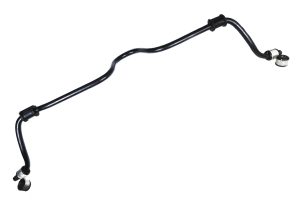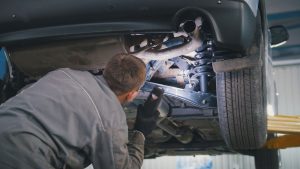If your vehicle starts making odd clunking or rattling noises — especially when turning or driving over bumps — it’s a sign something in the suspension system might be worn. One common yet often overlooked culprit is the sway bar, also known as the stabilizer bar or anti-roll bar. This component plays a key role in controlling body roll and stabilizing the car during cornering. When it starts to fail, it can create specific and recognizable sounds.
In this article, we’ll break down the types of noises sway bars make, what causes them, how to diagnose issues, and when to replace sway bar components to restore handling and comfort.
What Is a Sway Bar and What Does It Do?

A sway bar connects the left and right sides of a vehicle’s suspension. It reduces body roll during cornering by distributing weight evenly across both sides. It doesn’t directly impact ride quality on straight roads, but plays a vital role when the vehicle leans during a turn or uneven terrain.
Main Components:
| Component | Function |
|---|---|
| Sway Bar (Rod) | Transfers force between wheels to reduce body roll |
| End Links | Connect the bar to the suspension arms |
| Bushings | Cushions the sway bar at mounting points to reduce noise and friction |
| Mounting Brackets | Hold bushings in place, attaching the bar to the chassis |
What Suspension Noises Point to the Sway Bar?
Clunking, rattling, or knocking sounds — especially when going over speed bumps or turning — are often the first warning signs. Here’s a table summarizing the sounds and likely causes:
| Noise Type | Driving Condition | Possible Cause |
|---|---|---|
| Clunking | Over bumps or dips | Worn or broken sway bar bushings |
| Rattling | On uneven terrain | Loose or damaged sway bar end links |
| Creaking | During slow turns | Dry or cracked rubber bushings |
| Thud or Knock | When cornering sharply | Disconnected sway bar or snapped end link |
Common Sway Bar Issues That Cause Noise
-
Worn Bushings
-
Rubber or polyurethane bushings can degrade over time.
-
Causes excess movement of the sway bar, leading to clunking.
-
May produce creaking if dry or cracked.
-
-
Loose or Damaged End Links
-
End links are the connection point between the sway bar and suspension arms.
-
Metal-on-metal contact when broken can sound like a knock or rattle.
-
End links may bend, break, or have worn-out ball joints.
-
-
Corroded Mounting Points
-
Corrosion at the sway bar mounting brackets can loosen the sway bar’s grip.
-
Noise results from excessive movement.
-
-
Sway Bar Itself is Damaged
-
While rare, sway bars can crack or bend in accidents or from fatigue.
-
May cause loud knocking or unpredictable handling.
-
How to Diagnose Sway Bar Noise
You don’t always need a mechanic to detect sway bar issues. Here’s how you can diagnose it yourself:
Visual Inspection Checklist:
-
Look for cracked or missing rubber bushings
-
Wiggle the sway bar or end links — there should be minimal play
-
Check for rust or looseness in the brackets
-
Examine end links for missing nuts or broken joints
Road Test Behavior:
| Symptom | Sway Bar Involvement Likely? |
|---|---|
| Clunk only when turning | Yes |
| Noise disappears on smooth road | Yes |
| Constant knocking (even straight) | Possibly end links or shocks |
| Pulling or sway in turns | Likely |
Effects of a Failing Sway Bar
While sway bar failure won’t immediately strand you, it can compromise vehicle stability and safety, especially at higher speeds or during emergency maneuvers. Here are the key effects:
-
Increased body roll in corners
-
Reduced steering responsiveness
-
Poor load distribution across tires
-
Increased tire wear on outer edges
-
Higher rollover risk for SUVs and vans
Repair and Replacement Options
When any part of the sway bar system is compromised, replacement is the best option. Here’s what you might need:
Sway Bar Component Replacement Table:
| Component | Typical Cost (EUR) | DIY Difficulty | Notes |
|---|---|---|---|
| Sway Bar Bushings | €10–€40 | Low | Should be replaced in pairs |
| End Links | €20–€80 | Medium | Varies by vehicle type |
| Complete Sway Bar | €60–€150+ | Medium/High | Usually includes bushings & links |
| Professional Install | €100–€300 | N/A | Recommended for complex setups |
When to Replace vs. Repair
| Situation | Action to Take |
|---|---|
| Minor bushing noise, no handling issue | Lubricate or replace bushings |
| Noise plus poor cornering control | Replace bushings and end links |
| Broken or missing sway bar component | Replace full assembly |
| SUV used for towing/off-road | Upgrade to heavy-duty sway bar setup |
Preventative Tips for a Quiet Suspension

-
Lubricate sway bar bushings annually (especially in dry climates)
-
Inspect suspension at every oil change
-
Replace parts in pairs (left/right) for balance
-
Avoid excessive loads if sway bar shows signs of wear
Ready to Replace Faulty Components?
Don’t let a noisy suspension undermine your driving confidence. Whether it’s squeaky bushings or clunky end links, timely repairs will restore your vehicle’s handling and safety.
Buy Stabilizer & Components online — quality sway bars, bushings, and end links available with fast shipping and perfect fitment.
Final Thoughts
Noises from your suspension aren’t just annoying — they’re your car’s way of asking for attention. If you hear clunks, creaks, or rattles when cornering or driving over bumps, don’t ignore them. The sway bar system is often at the root of such noises and plays a key role in keeping your vehicle balanced and safe.
Perform regular inspections, replace worn-out parts with quality components, and don’t wait for minor issues to become major repairs. With the right attention and parts, your ride can be smooth, quiet, and confidently planted to the road.